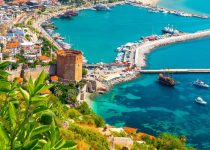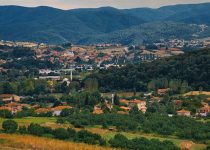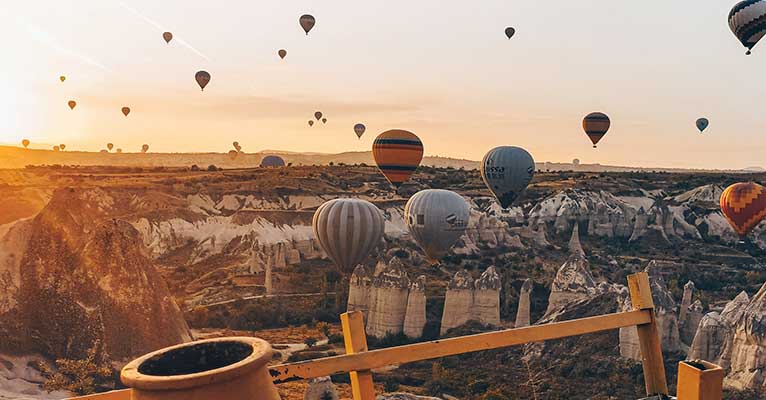Everything You Need to Know About Pamukkale Turkey
Pamukkale, Turkey’s beautiful tourist destination known as Cotton Castle, is a UNESCO World Heritage Site, combining natural and man-made art. Over two million visitors visit the site annually. Pamukkale is a geological wonder and cultural and historical treasure, offering a glimpse into ancient history and a serene environment for modern travelers. Visitors can explore Hierapolis’ ruins or indulge in soothing thermal pools, leaving a lasting impression on their visit.
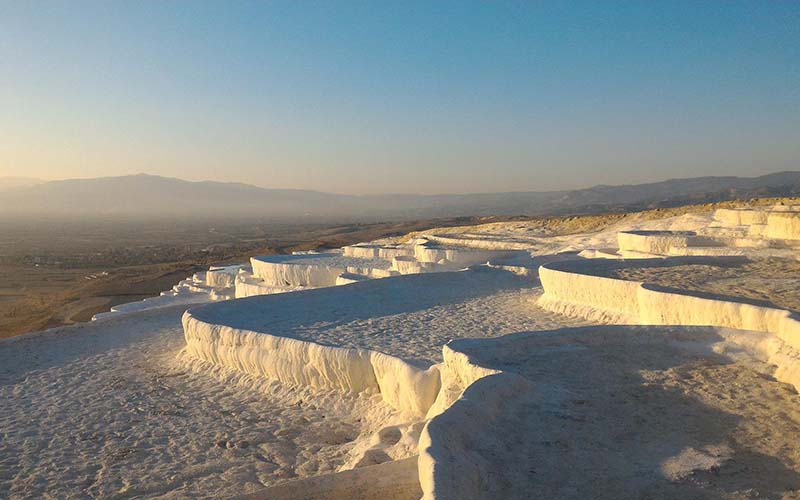
Where to Stay?
If you want a luxurious experience, the area has many thermal hotels with natural hot spring pools. Most of these hotels are in Karahayıt, about a 10-minute drive from Pamukkale’s most famous attractions. The Halici Hotel offers private thermal pools, a Turkish bath, massage services, an all-you-can-eat breakfast buffet, and excellent service.
For more budget-friendly stays, there are also many boutique hotels in both Pamukkale town and Karahayıt. Pamukkale town is closer to the main attractions, so if you want to stay within walking distance of the thermal pools and Hierapolis, book a hotel there. If you do not mind driving or taking a taxi, Karahayıt also has satisfying, slightly cheaper accommodation options. The city of Denizli, about 20 minutes away by car, also has various hotels.
Another choice during your Pamukkale visit is camping at Baydil Camping, located right in Pamukkale town. You may pitch a tent or park the camper at this affordable, fun option. Showers and bathrooms are included in the camping fee.
Best Time to Visit
The optimal period to travel to Pamukkale is between April and May. During these months, the weather is pleasant, and there is extra daylight. September to October is also considered a fine time to go. September signals the beginning of fall. The weather is mild, and the days become shorter. You should avoid journeying from June to August as this is the most scorching time. Temperatures hover about 40°C during the day. Be sure to bring light clothing. when you visit Turkey in August or even June or July.
Total Time to Spend
One day is sufficient to see the main attractions in Pamukkale. In addition to the cotton castle terraces and the ancient city of Hierapolis, you can also partake in activities like hot air balloon rides and paragliding. A hot air balloon tour lasts 35-45 minutes as you float over the white limestone terraces. Observing the sunrise over the valleys from a sky-high perspective is captivating, and later celebrate with a champagne toast when you land.
Entrance Fee
The price of a ticket is 25 Turkish Lira. This ticket allows you access to Hierapolis and Pamukkale for the entire day. It is good to be aware that there is an additional charge of 32 Turkish lira if you want to swim in the Cleopatra Pools at Hierapolis. If you have purchased a monthly Turkish Museum Pass, you can get into Pamukkale without having to wait in line since it is one of the included sites.
Opening Hours
During the summer months of April through October, the operating hours for Pamukkale are from 6am until midnight. When winter comes, Pamukkale opens at the same early hour of 6 am but closes much earlier at 6:30 pm.
Things to Do
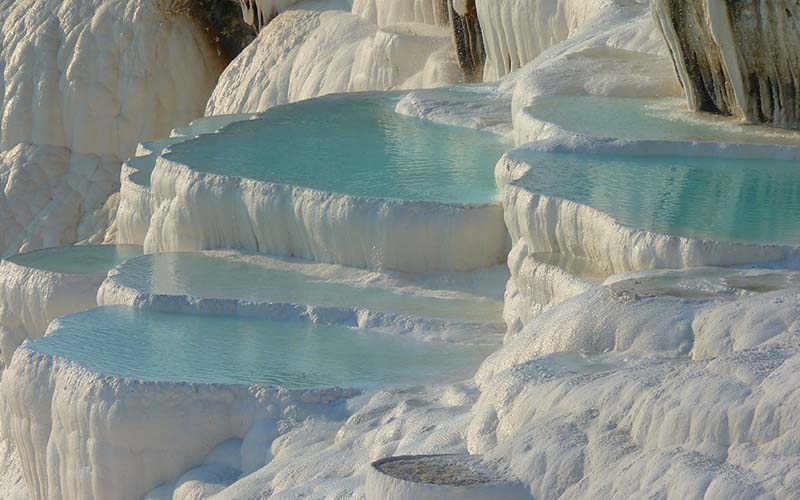
- Pamukkale Nature Park- Head to this outdoor nature park, where many Turkish families enjoy their free time. As an outgoing person, you can join them and make Turkish friends; they are warm and welcoming to visitors. This park is perfect for picnics, family time, and socializing. There is a cafe nearby where you can unwind, eat, and strike up good conversations. It is also a popular wedding venue, so you may spot lovely brides if you are fortunate.
- Paragliding- Though a bit expensive, paragliding helps you avoid the crowds and see Pamukkale from a new perspective. The 30-minute paragliding excursion is suitable for beginner paragliders since the company provides equipment and safety instructions before taking off with a certified tandem teacher.
- Hot Air Balloon Ride- Another choice to view the travertines from above is a hot air balloon ride. Instead of being an all-day activity, the balloons launch at sunrise, when the winds are strongest. After receiving safety instructions, you climb into the basket and spend an hour floating over the travertines as the balloon carries you through the air.
- Red Springs of Karahayit- Known as Pamukkale’s cousin, the Red Springs are a short drive away, and visitors swim in these springs. Spanning 500 square meters, it has red, muddy waters, transforming the calcium pools into a different color, thus its name. Renowned for its healing properties that alleviate skin diseases and high blood pressure, people frequently reserve a room at a nearby hotel for an overnight excursion bathe in Karahayit’s red waters.
- Laodicea- Automobile travelers should take a brief journey to Laodicea, one of the Seven Churches discussed in the Book of Revelation in the New Testament of the Bible. The city was denounced by Saint John the Disciple for being indifferent, and before residents deserted it many centuries ago, it was a prosperous commercial harbor. Nowadays, the ruins include the remarkable temple devoted to Athena. Although its impressive remnants remain, only a few people go to Laodicea, so this is an excellent opportunity to avoid the crowds.
- Denizli Arma Restaurant- The restaurant is located in the Avm Yolu Forum in Pamukkale. They serve a wide variety of cuisines, but Turkish cuisine is their specialty. Try the Turkish breakfast and Turkish coffee. The staff is friendly and helpful in guiding you on what to order. It is popular with both locals and tourists. The atmosphere is relaxed. It is also great for family meals. This is among the best things to do in Pamukkale.
- Thermal Pools- Pamukkale is called the Cotton Castle due to its unique hot springs located within thick layers of white limestone. The mineral-rich pools have varying temperatures, some feeling like normal hot tubs and others having a lukewarm or even cold temperature. When visiting the pools, be sure to remove your shoes to avoid harming the limestone.
- Temple of Apollo- The ruins of this temple are also worth seeing. The Plutonium Cave is beneath the temple of Apollo, and ot gets its name from the god Pluto. Ancient writers like Strabo talked about the fumes in the cave being fatal.
- Pamukkale Dervish Show- This entertainment performance is an excellent chance to become familiar with the customs and heritage of the Dervishes. The spinning dervishes carry out and move rhythmically to convey feelings and attain the insight and affection of God. This spiritual and remarkable presentation is a distinctive encounter for kids and grown-ups.
Apart from these, you can also view the gorgeous sunsets over the landscape and travertines, explore the wineries to taste local wine, visit St. Philip Martyrium, pamper yourself at spa and wellness centers, and explore the local shops and markets that sell everything from textiles, ceramics, souvenirs, handicrafts, and more. So, by now, you are well aware of what to do in Pamukkale, right?
FAQs
Q1. What is the specialty of Pamukkale?
Pamukkale, which translates to “cotton castle” in Turkish, is a natural landmark in Denizli Province in the southwestern region of Turkey. This area is well-known for the carbonate mineral deposits that have accumulated over time due to the flow of warm spring water in the region.
Q2. Can I click photos in Pamukkale?
Visitors are permitted to take photographs. However, there may be some limitations in particular locations to protect the natural area, and the operation of drones could be banned.
Q3. Are guided tours available?
You can go on guided tours at Pamukkale that give you information about the history and geology of the area. Tours are available in groups that you may join or hire a local guide.
Q4. Is it Child-friendly?
Pamukkale is child-friendly, but they need to be watched, particularly on the terraces. The hot springs in the Antique Pool region can be a fun activity for families.
Q5. What to wear in Pamukkale?
Wearing loose and lightweight clothes is advised, particularly during the hottest times of the year. If you intend to take a dip in the Antique Pool, be sure to pack your swimsuit. Wear a hat, apply sunscreen, and put on cozy shoes suitable for walking.
Q6. Can I carry food and drinks?
You usually cannot bring your own food and drinks to the location because they do not want trash everywhere. But there are places to buy food and drinks inside if you need something.
Q7. What other attractions are near Pamukkale?
Places of interest near Pamukkale include the ruins of the old city of Aphrodisias, the present-day city of Denizli, and the archaeological remains at Laodicea on the Lycus.
Q8. Is there any entrance fee for kids?
Kids mostly enjoy reduced admission fees or can enter Pamukkale for free based on their age.
Q9. Is Pamukkale wheelchair accessible?
Although there are attempts to make some parts accessible, the natural landscape of Pamukkale can present difficulties for wheelchair users. The old city of Hierapolis might have some restrictions when it comes to accessibility.
Q10. How to reach Pamukkale?
By air- You can travel by flight to Denizli from other big cities in Turkey. After arriving in Denizli, board a bus or taxi that transfers you to Pamukkale.
By bus- You may travel by bus to Denizli from big cities such as Istanbul, Ankara, Izmir, and more. After arriving at Denizli’s bus station, you can take bus or taxi to Pamukkale.
By car– If you prefer driving, you can rent a vehicle, and use a GPS or follow the road signs to get to Pamukkale.
Organized tours- Numerous travel companies provide planned excursions to Pamukkale from the main tourist destinations in Turkey.
